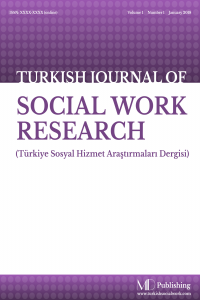Abstract
Küresel ölçekte bakıldığında, sosyal hizmet eğitimci çevresinde artan yoğunlukta süren bir tartışma, sosyal hizmet eğitiminin bilişim teknolojilerinin uzantısı olan uzaktan eğitime ne oranda başvurularak yapılabileceğidir. Bilişim teknolojilerinin, sosyal hizmet gibi kişilerarası etkileşim üzerine kurulu mesleklerin eğitimiyle bütünleşmesi kaçınılmazdır. Çevrimiçi gerçekleştirilen uzaktan eğitimin temel özelliği öğrenci ve öğreticinin hem zeminde, hem de zamanda ayrılmasıdır. Bunun dışında çevrimiçi eğitimin içeriği ile örgün eğitimin içeriği arasında ayırt edici bir fark bulunmamaktadır. Sosyal hizmetin toplumun her kesimine gereksinim duyulan kaynakların ve hizmetlerin ulaşmasının sağlanması idealiyle uzaktan eğitimin temel nosyonu arasında bir örtüşme oluşmaktadır. Uzaktan eğitim uygulamaları bu yönüyle bakıldığında, toplumdaki fırsat eşitliğine hizmet etmektedir. Çevrimiçi eğitim, hem klasik-didaktik hem de yapısalcı öğrenme perspektiflerinin ikisi için de uygun bir ortam sağlamaktadır. Eğitimde yaşanan teknoloji tabanlı gelişmeler mesleki yaşamımızı dönüştürmeye devam etmektedir. Sosyal hizmet mesleği için uzaktan eğitimi, çevrimiçi eğitim düzeyinden bakmak koşuluyla bir tehlikeden çok bir fırsat olarak görmenin daha uygun olduğu düşünülmektedir.
Supporting Institution
Yok
Project Number
Yok
Thanks
Yok
References
- Barnett-Queen, T., Blair, R. ve Merrick, M. (2005). Student Perspectives of Online Discussions: Strengths and Weaknesses. Journal of Technology in Human Services, 23(3), 229-244.
- Dalton, B. (2001). Distance education: A multidimensional evaluation. Journal of Technology in Human Services, 18(3-4), 101-115.
- Glezakos, A. (2005). The tribulations and rewards of distance education teaching. In P. Abels (Ed.), Distance education in social work: Planning, teaching and learning (pp. 71-83). New York: Springer.
- Hamilton, L. (2017). Distance Education In Social Work: A Review Of The Literature. Professional Development: The International Journal of Continuing, 20(2), 45-56.
- Huntington, A. ve Sudbery, J. (2005). Virtual classrooms: experiences of European collaborative teaching and learning. Social work education, 24(3), 363-371.
- Ligon, J., Markward, M. J. ve Yegidis, B. L. (1999). Comparing Student Evaluations of Distance Learning and Standard Classroom Courses in Graduate Social Work Education. Journal of Teaching in Social Work, 19(1), 21-29.
- Madoc-Jones, I. ve Parrott, L. (2005). Virtual social work education—theory and experience. Social work education, 24(7), 755-768.
- Moore, B. (2005). Key Issues in Web-Based Education in the Human Services: A Review of the Literature. Journal of Technology in Human Services, 23(1), 11-28.
- Payne, M. ve Askeland, G. A. (2008). Globalization and international social work : postmodern change and challenge. Aldershot, England ; Burlington, VT: Ashgate.
- Petracchi, H. E. (2000). Distance education: what do our students tell us? Research on Social Work Practice, 10(3), 362.
- Rafferty, J. ve Waldman, J. (2006). Fit for virtual social work practice? Journal of Technology in Human Services, 24(2-3), 1-22.
- Ritzer, G. (1993). The McDonaldization of society: An investigation into the changing character of contemporary social life. Thousand Oaks; London: Pine Forge.
- Schoech, D. ve Helton, D. (2002). Qualitative and quantitative analysis of a course taught via classroom and internet chatroom. Qualitative Social Work, 1(1), 111.
- Taylor, J. C. (2001). Fifth Generation Distance Education. (Higher education series Report No. 40 June, Australia Department of Education, Training and Youth Affaires, Higher Education Division) Retrieved 25/11, 2011, from http://www.dest.gov.au/archive/highered/hes/hes40/hes40.pdf
- Vernon, R., Vakalahi, H., Pierce, D., Pittman-Munke, P. ve Adkins, L. F. (2009). Distance education programs in social work: Current and emerging trends. Journal of Social Work Education, 45(2), 263-276.
Abstract
Project Number
Yok
References
- Barnett-Queen, T., Blair, R. ve Merrick, M. (2005). Student Perspectives of Online Discussions: Strengths and Weaknesses. Journal of Technology in Human Services, 23(3), 229-244.
- Dalton, B. (2001). Distance education: A multidimensional evaluation. Journal of Technology in Human Services, 18(3-4), 101-115.
- Glezakos, A. (2005). The tribulations and rewards of distance education teaching. In P. Abels (Ed.), Distance education in social work: Planning, teaching and learning (pp. 71-83). New York: Springer.
- Hamilton, L. (2017). Distance Education In Social Work: A Review Of The Literature. Professional Development: The International Journal of Continuing, 20(2), 45-56.
- Huntington, A. ve Sudbery, J. (2005). Virtual classrooms: experiences of European collaborative teaching and learning. Social work education, 24(3), 363-371.
- Ligon, J., Markward, M. J. ve Yegidis, B. L. (1999). Comparing Student Evaluations of Distance Learning and Standard Classroom Courses in Graduate Social Work Education. Journal of Teaching in Social Work, 19(1), 21-29.
- Madoc-Jones, I. ve Parrott, L. (2005). Virtual social work education—theory and experience. Social work education, 24(7), 755-768.
- Moore, B. (2005). Key Issues in Web-Based Education in the Human Services: A Review of the Literature. Journal of Technology in Human Services, 23(1), 11-28.
- Payne, M. ve Askeland, G. A. (2008). Globalization and international social work : postmodern change and challenge. Aldershot, England ; Burlington, VT: Ashgate.
- Petracchi, H. E. (2000). Distance education: what do our students tell us? Research on Social Work Practice, 10(3), 362.
- Rafferty, J. ve Waldman, J. (2006). Fit for virtual social work practice? Journal of Technology in Human Services, 24(2-3), 1-22.
- Ritzer, G. (1993). The McDonaldization of society: An investigation into the changing character of contemporary social life. Thousand Oaks; London: Pine Forge.
- Schoech, D. ve Helton, D. (2002). Qualitative and quantitative analysis of a course taught via classroom and internet chatroom. Qualitative Social Work, 1(1), 111.
- Taylor, J. C. (2001). Fifth Generation Distance Education. (Higher education series Report No. 40 June, Australia Department of Education, Training and Youth Affaires, Higher Education Division) Retrieved 25/11, 2011, from http://www.dest.gov.au/archive/highered/hes/hes40/hes40.pdf
- Vernon, R., Vakalahi, H., Pierce, D., Pittman-Munke, P. ve Adkins, L. F. (2009). Distance education programs in social work: Current and emerging trends. Journal of Social Work Education, 45(2), 263-276.
Details
| Primary Language | Turkish |
|---|---|
| Subjects | Sociology (Other) |
| Journal Section | Research Articles |
| Authors | |
| Project Number | Yok |
| Publication Date | May 31, 2020 |
| Submission Date | May 4, 2020 |
| Acceptance Date | May 28, 2020 |
| Published in Issue | Year 2020 Volume: 4 Issue: 1 |


